高中英语 it的用法
高中英语It的用法
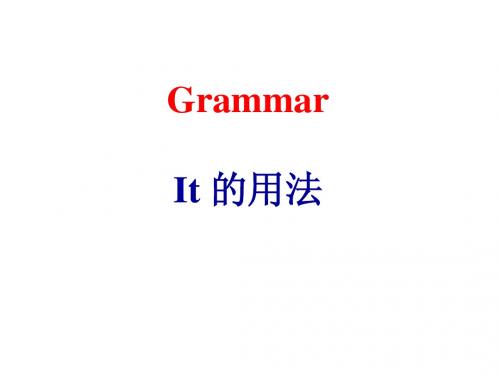
9. Meeting my uncle after all these years was an unforgettable moment, _____ I will always B treasure. A.that B.one C.it D.What A 10. I prefer a flat in Inverness to ______in Perth, because I want to live near my Mom’s. A. one B. that C. it D. this 11. Cars do cause us some health problems — in B fact far more serious _______ than mobile phones do. A.one B.ones C.it D.those
Grammar It 的用法
1. it 作形式主语,代替不定式、动名词短语或主 语从句表示的真正主语: It is hard to deal with him. It is impossible for her to come. It is no good/use waiting here. It is evident that he is lying. It is not clear whether he will go or not. 2. it 作形式宾语,代替不定式、动名词短语或宾 语从句表示的真正宾语: I think it easy to repair the radio. I find it hard for her to do the math problems. He felt it no use learning English. I think it necessary that we should take exercise.
英语语法:高中英语It的用法

【导语】"It"⽤法及其句型和固定搭配,是⾼中英语语法的重点、难点,⼜是近⼏年⾼考的热点,因此应给予充分的重视,⽆忧考整理了“it的⽤法”,欢迎阅读参考!更多相关讯息请关注⽆忧考!⼀、It⽤作实词表达以下概念:指代前⽂提到的事物,如前⽂中的this, that;替代前⽂中的内容;指代⼀位性别不明的⼩孩或未知的⼈;指代未指明但谈话双⽅都知道的那件事;指代时间、天⽓、⽓候、距离等⾃然现象……⼆、It⽤作形式主语替代作主语的从句、动词不定式、动名词,⽽把真正作主语的从句、动词不定式、动名词置于句尾。
It 作形式主语的常见句型:1. 代作主语的动词不定式,其句型为:(1) It be adj. (for sb.) to do sth.此处adj. 通常为描述事件的形容词:easy, difficult, hard, necessary, unnecessary, possible, impossible, likely, unlikely, right, wrong, important, unimportant, legal, illegal, well-mannered, ill-mannered, polite, impolite, clear, obvious, certain, suitable, proper, fit, useful, useless, dangerous…例: It is illegal (for a teenager) to drive a car without a license.(2) It be adj. of sb. to do sth.此处adj. 通常为描述⼈的形容词:kind, unkind, nice, rude, cruel, considerate, thoughtful, thoughtless, careful, careless, silly, foolish, stupid, clever, wise, crazy.例: It's kind of you to help me with the problem.(3) It替代作主语的动名词的常见句型:It's no good/use doing…It's (well)worth doing…It's (well)worth one's while doing/to do…It's (well)worth while doing/ to do例: It's no use crying over spilt milk(覆⽔难收).2. It替代作主语的从句常见句型:(1) It is + noun +从句例: It is no secret that the president wants to have a second term at office.(2) It is adj. +clauseIt's surprising that… (should)………竟然……It's a pity/shame that…(should)………竟然……例: It's important that you should apologize to her for your rudeness.(=It's of much importance that you should apologize to her for your rudeness.)(3) It verb sb. + clause= It is v-ing + clauseIt+surprise/delight/interest/disappoint/worry/disturb/annoy/amaze /bother/concern/frighten/please/anger sb. that…例: It worried me that she drove so fast.(= It was worrying that she drove so fast.)(4) It verb (to sb.) that…= sb/sth verb to do例: It (so) happened/chanced that they were out.(= They happened/chanced to be out.)(5) It is v-ed that…=sb/sth is to do(verb=say, report, think, believe, hope, expect, agree, accept, decide, determine, intend, plan, understand, know)例: It is said that the couple have gotten divorced.(=The couple are said to have gotten divorced.)(6) It is v-ed that … (should)…(verb=demand, request, require, order, suggest, advise, recommend例 It is suggested that they should begin with the third question.三、It作主语的句型1. It takes sb. … to do…(=sb takes…to do…)某⼈⽤多长时间做某事例: It took the men a week to mend our roof.(= The men took a week to mend our roof.)2. It's (just)(un)like sb. to do…(不)像某⼈做某事的风格例: It was (just) like him to think of helping us.3. It's (about/high) time that… should /v-ed…是该做某事的时候了例: It's(about/high) time that we should take action.4. It's the x-th time (that) … have v-ed…第⼏次做某事了例: It's the third time that he has failed the driving test.5. It is/has been… since …continuous v-ed(延续性动词) 某动作持续了多长时间例: It's 10 years since he lived here6. It was(not)… before…过(不)了多长时间某动作发⽣了例: It was not long before they arrived.四、It 作形式宾语⽤来替代作宾语的从句、动词不定式、动名词,⽽把真正作宾语的从句、动词不定式、动名词置于句尾。
it用法
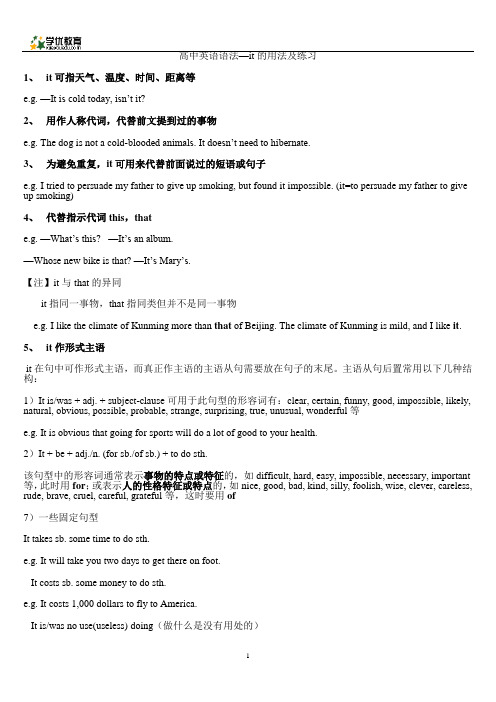
高中英语语法—it的用法及练习1、it可指天气、温度、时间、距离等e.g. —It is cold today, isn’t it?2、用作人称代词,代替前文提到过的事物e.g. The dog is not a cold-blooded animals. It doesn’t need to hibernate.3、为避免重复,it可用来代替前面说过的短语或句子e.g. I tried to persuade my father to give up smoking, but found it impossible. (it=to persuade my father to give up smoking)4、代替指示代词this,thate.g. —What’s this?—It’s an album.—Whose new bike is that? —It’s Mary’s.【注】it与that的异同it指同一事物,that指同类但并不是同一事物e.g. I like the climate of Kunming more than that of Beijing. The climate of Kunming is mild, and I like it.5、it作形式主语it在句中可作形式主语,而真正作主语的主语从句需要放在句子的末尾。
主语从句后置常用以下几种结构:1)It is/was + adj. + subject-clause可用于此句型的形容词有:clear, certain, funny, good, impossible, likely, natural, obvious, possible, probable, strange, surprising, true, unusual, wonderful等e.g. It is obvious that going for sports will do a lot of good to your health.2)It + be + adj./n. (for sb./of sb.) + to do sth.该句型中的形容词通常表示事物的特点或特征的,如difficult, hard, easy, impossible, necessary, important 等,此时用for;或表示人的性格特征或特点的,如nice, good, bad, kind, silly, foolish, wise, clever, careless, rude, brave, cruel, careful, grateful等,这时要用of7)一些固定句型It takes sb. some time to do sth.e.g. It will take you two days to get there on foot.It costs sb. some money to do sth.e.g. It costs 1,000 dollars to fly to America.It is/was no use(useless) doing(做什么是没有用处的)e.g. It’s no use arguing with him.It is/was no good doing(做什么是没有好处的)8)以下句型结构中需要用虚拟语气①It is/was important(necessary, strange) that…; It is/was ordered(required, suggested, proposed) that…; It is/was a pity(a shame) that…表示遗憾等感情的句子中,主语从句要用“should+动词原形”,should可以省略。
高中英语语法知识之It的用法总结

高考英语语法知识之It 的用法总结1. It is + 被强调部分+ that ...该句型是强调句型。
将被强调的部分放在前面, 其它部分置于that之后。
被强调部分可以是主语, 宾语, 状语。
强调的主语如果是人, that可以由who换用。
如果把这种句型结构划掉后, 应该是一个完整无缺的句子。
这也是判断强调句型与其它从句的方法。
I.wa.the.tha.(who.cleane.th.classroo.yesterday.I.wa.i.th.stree.tha..me.he.father.2. It was not until + 被强调部分+ that ...该句型也是强调句型。
主要用于强凋时间状语,译成汉语"直到...才...",可以说.no....unti....的强调形式. It was not until she took off her dark glasses that I realized she was a famous film star.= Not until she took off her dark glasses did I realize she was a famous film star...didn’.realiz.sh.wa..famou.fil.sta.unti.sh.too.of.he.dar.glasses.3. It is clear ( obvious, true, possible,certain....)that .....该句型中it 是形式主语, 真正的主语是that 引导的主语从句, 常译为"清楚(显然, 真的, 肯定...)"是主语从句最常见的一种结构。
It is very clear that he’s round and tall like a tree.= That he’s round and tall like a tree is very clear.4.I.i.importan..necessary.right.strange.natural....tha....由于主句中的形容词不同, tha.后的从句中要用虚拟语气(shoul..动词原形), shoul.可以省去。
“It”用法及其句型和固定搭配讲解
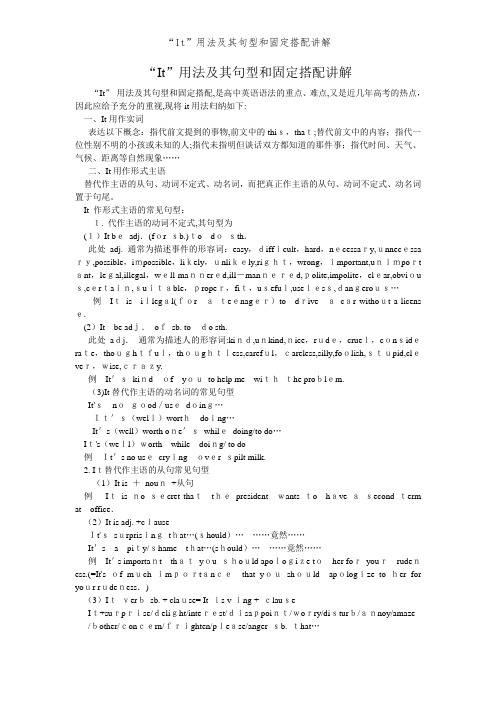
“It”用法及其句型和固定搭配讲解“It”用法及其句型和固定搭配,是高中英语语法的重点、难点,又是近几年高考的热点,因此应给予充分的重视,现将it用法归纳如下:一、It用作实词表达以下概念:指代前文提到的事物,前文中的this,that;替代前文中的内容;指代一位性别不明的小孩或未知的人;指代未指明但谈话双方都知道的那件事;指代时间、天气、气候、距离等自然现象……二、It用作形式主语替代作主语的从句、动词不定式、动名词,而把真正作主语的从句、动词不定式、动名词置于句尾。
It 作形式主语的常见句型:1. 代作主语的动词不定式,其句型为(1)It beadj.(for sb.)to dosth.此处adj. 通常为描述事件的形容词:easy,difficult,hard,necessary,unnecessa ry,possible,impossible,likely,unlikely,right,wrong,important,unimport ant,legal,illegal,well-mannered,ill-mannered,polite,impolite,clear,obviou s,certain,suitable,proper,fit,useful,useless,dangerous…例Itis illegal(forateenager)to driveacar without a licens e.(2)It be adj.ofsb. todo sth.此处adj.通常为描述人的形容词:kind,unkind,nice,rude,cruel,considerate,thoughtful,thoughtless,careful,careless,silly,foolish,stupid,clever,wise,crazy.例It'skindof youto help me withthe problem.(3)It替代作主语的动名词的常见句型It'snogood/usedoing…It's(well)worthdoing…It's(well)worth one'swhiledoing/to do…It's(well)worth while doing/ to do例It's no usecryingover spilt milk.2. It替代作主语的从句常见句型(1)It is +noun+从句例Itis no secret thatthepresidentwants to have asecond term at office.(2)It is adj. +clauseIt'ssurprisingthat…(should)………竟然……It's a pity/shame that…(should)………竟然……例It's important thatyou should apologize toher foryourrudeness.(=It's of much importancethat youshould apologize to her for your rudeness.)(3)Itverbsb. + clause= It is v-ing + clauseIt+surprise/delight/interest/disappoint/worry/disturb/annoy/amaze /bother/concern/frighten/please/anger sb. that…例Itworried methatshe drove sofast.(=Itwas worrying that she droveso fast.)(4)Itverb(to sb.)that…= sb/sthverb todo(verb=appear,seem,come about,emerge,follow,chance,happen,occur,transpire,turn out,work out)例It(so)happened/chanced that they wereout.(=Theyhappened/c hancedto be out.)(5)It is v-ed that…=sb/sthis to do(verb=say,report,think,believe,hope,expect,agree,accept,decide,determine,intend,plan,understand,know)例It is said that the couple havegottendivorced.(=Thecouple are said to have gotten divorced.)(6)It isv-edthat …(should)…(verb=demand,request,require,order,suggest,advise,recommend例It is suggested that they should begin with the thirdquestion. “It”用法及其句型和固定搭配讲解2007-05-0117:14:05.0中国高中生网()三、It作主语的句型1.It takes sb.…todo…(=sb takes…todo…)某人用多长时间做某事例It took the menaweek to mendour roof.(= The men took a week t omendourroof.)2. It's(just)(un)like sb.to do…(不)像某人做某事的风格例Itwas(just)like himto think of helping us.3. It's(about/high)time that…should /v-ed…是该做某事的时候了例It's(about/high)timethat we shouldtake action.4.It'sthe x-th time(that)…have v-ed…第几次做某事了例It's the third time thathe has failedthe drivingtest.5.It is/has been…since…continuous v-ed(延续性动词)某动作已有多长时间不发生了例It's 10 years that he livedhere6.It was(not)…before…过(不)了多长时间某动作发生了例It was notlong before they arrived.四、It 作形式宾语用来替代作宾语的从句、动词不定式、动名词,而把真正作宾语的从句、动词不定式、动名词置于句尾。
高中英语It用法及其句型和固定搭配讲解
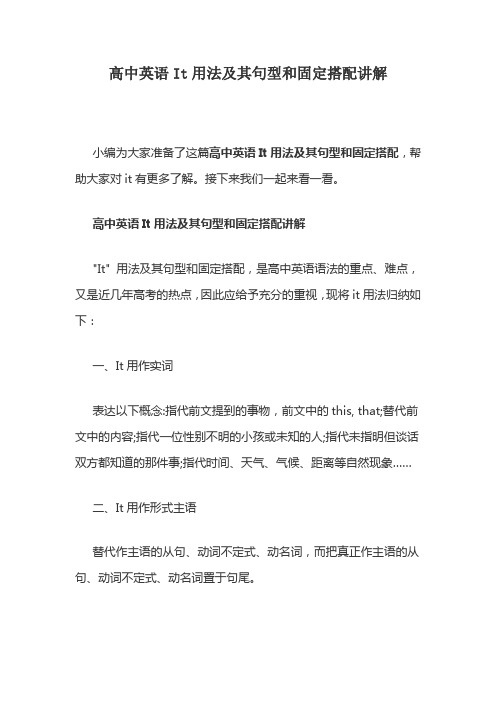
高中英语It用法及其句型和固定搭配讲解小编为大家准备了这篇高中英语It用法及其句型和固定搭配,帮助大家对it有更多了解。
接下来我们一起来看一看。
高中英语It用法及其句型和固定搭配讲解"It" 用法及其句型和固定搭配,是高中英语语法的重点、难点,又是近几年高考的热点,因此应给予充分的重视,现将it用法归纳如下:一、It用作实词表达以下概念:指代前文提到的事物,前文中的this, that;替代前文中的内容;指代一位性别不明的小孩或未知的人;指代未指明但谈话双方都知道的那件事;指代时间、天气、气候、距离等自然现象……二、It用作形式主语替代作主语的从句、动词不定式、动名词,而把真正作主语的从句、动词不定式、动名词置于句尾。
It 作形式主语的常见句型:1. 代作主语的动词不定式,其句型为(1) It be adj. (for sb.) to do sth.此处adj. 通常为描述事件的形容词:easy, difficult, hard,necessary, unnecessary, possible, impossible, likely, unlikely, right, wrong,important, unimportant, legal, illegal, well-mannered, ill-mannered, polite,impolite, clear, obvious, certain, suitable, proper, fit, useful, useless,dangerous…例It is illegal (for a teenager) to drive a car without a license.(2) It be adj. of sb. to do sth.此处adj. 通常为描述人的形容词:kind,unkind,nice,rude,cruel,considerate, thoughtful, thoughtless, careful, careless, silly, foolish,stupid, clever, wise, crazy.例It's kind of you to help me with the problem.(3) It替代作主语的动名词的常见句型It's no good/use doing…It's (well)worth doing…It's (well)worth one's while doing/to do…It's (well)worth while doing/ to do例It's no use crying over spilt milk.2. It替代作主语的从句常见句型(1) It is + noun +从句例It is no secret that the president wants to have a second term atoffice.(2) It is adj. +clauseIt's surprising that…(should)………竟然……It's a pity/shame that…(should)………竟然……例It's important that you should apologize to her for yourrudeness.(=It's of much importance that you should apologize to her for your rudeness.)(3) It verb sb. + clause= It is v-ing + clauseIt+surprise/delight/interest/disappoint/worry/disturb/ann oy/amaze/bother/concern/frighten/please/anger sb. that…例It worried me that she drove so fast.(= It was worrying that shedrove so fast.)(4) It verb (to sb.) that…= sb/sth verb to do(verb = appear, seem, come about, emerge, follow, chance, happen,occur, transpire, turn out , work out)例It (so) happened/chanced that they were out.(=They happened/chanced to be out.)(5) It is v-ed that…=sb/sth is to do(verb=say, report, think, believe, hope, expect, agree, accept,decide, determine, intend, plan, understand, know)例It is said that the couple have gotten divorced.(=The couple are said to have gotten divorced.)三、It作主语的句型1. It takes sb. …to do…(=sb takes…to do…)某人用多长时间做某事例It took the men a week to mend our roof.(= The men took a week tomend our roof.)2.It's (just)(un)like sb. to do…(不)像某人做某事的风格例It was (just) like him to think of helping us.3.It's (about/high) time that…should /v-ed…是该做某事的时候了例It's(about/high) time that we should take action.4.It's the x-th time (that) …have v-ed…第几次做某事了例It's the third time that he has failed the driving test.5.It is/has been…since …continuous v-ed(延续性动词) 某动作已有多长时间不发生了6.It was(not)…before…过(不)了多长时间某动作发生了四、It 作形式宾语用来替代作宾语的从句、动词不定式、动名词,而把真正作宾语的从句、动词不定式、动名词置于句尾。
高中英语it的用法的归纳总结

高中英语it的用法的归纳总结以下是关于 it 的用法的一些归纳总结:1. 当 it 作为形式主语时,常用动词不定式或名词形式充当主语,其后面通常会加上 for 或 to 引导的短语。
例如:- It"s important to study hard.(努力学习很重要。
)- It"s a beautiful day.(今天天气很好。
)- It"s difficult to imagine a better place to live.(无法想象一个更适合居住的地方。
)2. 当 it 作为形式宾语时,通常用不定式或名词形式充当宾语,并在其后加上 for 或 to 引导的短语。
例如:- I appreciate your help.(感谢你的帮助。
)- It"s a great opportunity for me to learn new skills.(这是一个我学习新技能的好机会。
)- It"s necessary to clean the room.(打扫房间有必要。
)3. 当 it 作为实义主语时,表示某一具体事物或人物。
例如: - It"s a beautiful day, isn"t it?(今天天气很好,是吗?) - It"s yours, isn"t it?(这是你的吗?)4. 当 it 作为强调句的结构时,通常位于句首,其后是句子的主要成分。
例如:- I don"t know who it was that called me yesterday.(我不知道昨天是谁给我打电话。
)- It was yesterday that I visited my grandmother.(昨天我去看望了我奶奶。
)5. 当 it 作为单数名词时,通常指某一类人或物中的一个。
例如:- It"s a police car.(这是一辆警车。
高中英语it的用法课件-(详细有高考题-精品)
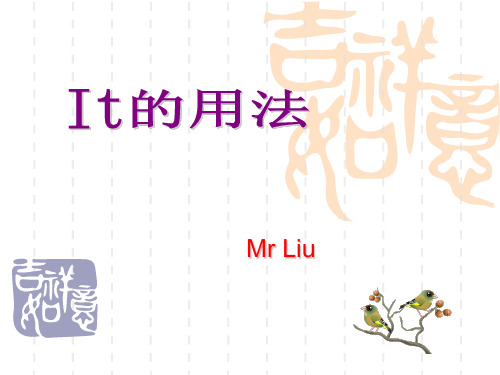
动词 +it + that + clause
enjoy, like, / love, dislike, appreciate hate, don't mind, be fond of, feel like, see to / depend on / insist on
例 : I hate it you can dance so well but I can't.
2.非人称代词it
it有时并不指具体的东西,而泛指天气、时间、环境等, 称为非人称的it: ⑴.指天气:
It is a lovely day, isn’t it? It is a bit windy.
⑵.指时间:
It was nearly midnight when she came back.
⑶.指环境:
no good 3. S + V + it +
no use
+ doing sth.
形式宾语归纳
该句型中的it 作形式宾语,记忆方便---“6123结构”。
6 主句中常用的动词: think,believe,make,find,consider,feel; 1 形式宾语it; 2 宾补的两种形式:形容词或名词; 3 真正宾语的三种形式:
an honour
…
… said It is / was p.p. known + that-clause believed
…
1. It is clear ( obvious, true, possible, certain....) that .....
该句型中it 是形式主语,真正的主语是that 引导的主 语从句,常译为“清楚(显然,真的,肯定...)” 是主语从句最常见的一种结构。
高考英语It的用法

高考英语It的用法It是高考英语中一个极其重要的词,其用法多样,在不同的语境中具有不同的意义。
下面我们将从it的用法、句型和固定搭配三个方面进行讲解。
一、it用作实词1、表示时间、天气、距离、温度等自然现象。
例如:It is Monday today.今天是星期一。
It is raining outside.外面正在下雨。
It is 5 kilometers away from here.距离这儿有5公里远。
2、表示观点、看法、态度等主观想法。
例如:I think it is a good idea.我认为这是一个好主意。
We think it is important to learn English well.我们认为学好英语很重要。
二、it用作形式主语当不定式、动名词或从句作主语时,为了保持句子结构平衡,避免头重脚轻,常用it作形式主语,代替不定式、动名词或从句,而把真正的主语放在句尾。
例如:It is important to learn English well.学好英语很重要。
It took me an hour to finish the homework.我花了一个小时完成作业。
三、it用作形式宾语当不定式、动名词或从句作宾语时,为了保持句子结构平衡,避免头重脚轻,常用it作形式宾语,代替不定式、动名词或从句,而把真正的宾语放在句尾。
例如:I think it is important to learn English well.我认为学好英语很重要。
He found it hard to learn English well.他发现学好英语很难。
四、it用于强调句型中强调句型是英语中一个重要的句型,用于突出强调某个成分,特别是主语、宾语和状语等。
在强调句型中,it没有实际意义,只是起到引导作用。
例如:It is I who am the best student in my class.我是班里最好的学生。
【高中英语】高中英语语法:It的完整用法

【高中英语】高中英语语法:It的完整用法除了课堂上的学习外,平时的积累与练习也是学生提高成绩的重要途径,本文为大家提供了高中英语语法:it的完整用法,祝大家阅读愉快。
it可用作人称代词、指示代词、先行词及引导词等。
1.人称代词it,就是第三人称单数中性,代表前文已提及过的一件事物。
例如:1)thatvaseisvaluable.it'smorethan200yearsold.那个花瓶很珍贵,它有200多年的历史。
2)iloveswimming.itkeepsmefit.我讨厌游泳,它能够并使我维持身心健康。
当说话者不清楚或无必要知道说话对象的性别时,也可用it来表示。
如:3)it'salovelybaby.isitaboyoragirl?宝宝真可爱,就是男孩还是女孩?it可用来指代团体。
如:it用来替代命令代词this,that.如:5)---what'sthis?---it'sapen.—这是什么?—是一支钢笔。
6)---whosebookisthat?---it'smike's.—那就是谁的书?—就是迈克的。
2.指示代词it,常用以指人。
如:7)goandseewhoitis.回去看一看就是谁。
8)---whoismakingsuchanoise?—是谁发出这样的吵闹声?---itmustbethechildren.—一定就是孩子们。
3.虚义it无指代性,常用作没有具体意义的主语,出现于表示天气、气候、温度、时间、地点、距离等意义的句子中。
如:9)itishalfpastthreenow.现在就是三点半钟。
10)itissixmilestothenearesthospitalfromhere.这里离最近的医院也有六英里。
11)itwasverycold;itsnowedandgrewdark.天气很冷;天下着雪,渐渐地变黑了。
以上就是为大家整理的高中英语语法:it的完备用法,期望同学们写作后会对自己有所协助,预祝大家写作开心。
高中英语语法知识之It的用法总结
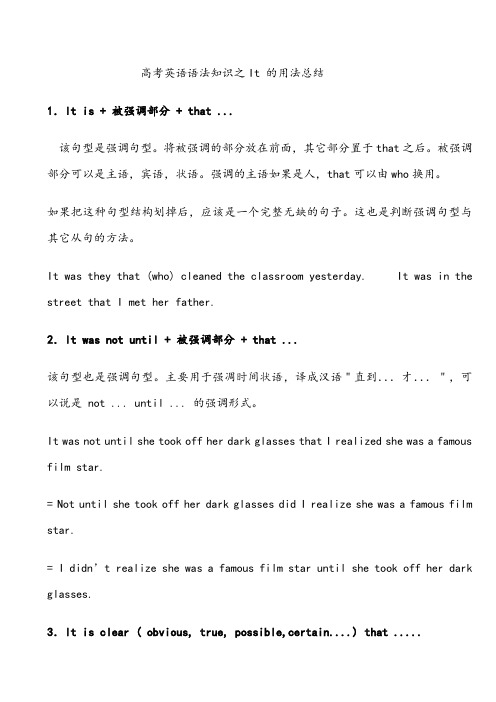
高考英语语法知识之It 的用法总结1.It is + 被强调部分 + that ...该句型是强调句型。
将被强调的部分放在前面,其它部分置于that之后。
被强调部分可以是主语,宾语,状语。
强调的主语如果是人,that可以由who换用。
如果把这种句型结构划掉后,应该是一个完整无缺的句子。
这也是判断强调句型与其它从句的方法。
It was they that (who) cleaned the classroom yesterday. It was in the street that I met her father.2.It was not until + 被强调部分 + that ...该句型也是强调句型。
主要用于强凋时间状语,译成汉语"直到...才...",可以说是 not ... until ... 的强调形式。
It was not until she took off her dark glasses that I realized she was a famous film star.= Not until she took off her dark glasses did I realize she was a famous film star.= I didn’t realize she was a famous film star until she took off her dark glasses.3.It is clear ( obvious, true, possible,certain....) that .....该句型中it 是形式主语,真正的主语是that 引导的主语从句,常译为"清楚(显然,真的,肯定...)"是主语从句最常见的一种结构。
It is very clear that he’s round and tall like a tree.= That he’s round and tall like a tree is very clear.4. It is important ( necessary, right, strange, natural...) that ...由于主句中的形容词不同,that 后的从句中要用虚拟语气(should + 动词原形),should 可以省去。
高中阶段It常用句型解析及运用

高中阶段It常用句型解析及运用一、It作形式主语1.It 代替不定式,常用于以下结构:It+ be+ adj./ n. +( for sb )to do sth;It+ be+ adj. +of sb to do sthIt takes +sb+一段时间+ to do①It is important for us to master a foreign language.对于我们来说,掌握一门外语是十分重要的。
②It is very kind of you to help me with my English.你帮我学英语,真是太好了。
③It will take about two days to drive to Shanghai.开车去上海大约要两天的时间。
2.It代替动名词,常用于以下句型中:It is no use doing sth. 做……没有用。
It is no good doing sth. 做……没好处It is fun doing sth. 做……有趣①It’s no use crying over spilt milk.覆水难收。
②It’s no good eating some fast food.吃快餐是没有好处的。
③It’s great fun jumping into the swimming pool in summer.夏天跳进游泳池里游泳是件有趣的事。
3.It代替that从句,常用于以下句型中:It be +adj./ n. +that从句It be +过去分词+ that 从句It seems / appears / happens / turns out that 从句It ourred to sb+ that从句①I don’t know the restaurant, but it’s said that it’s quite a good one.我不知道这家饭馆,但听说相当不错。
高中英语语法it的用法
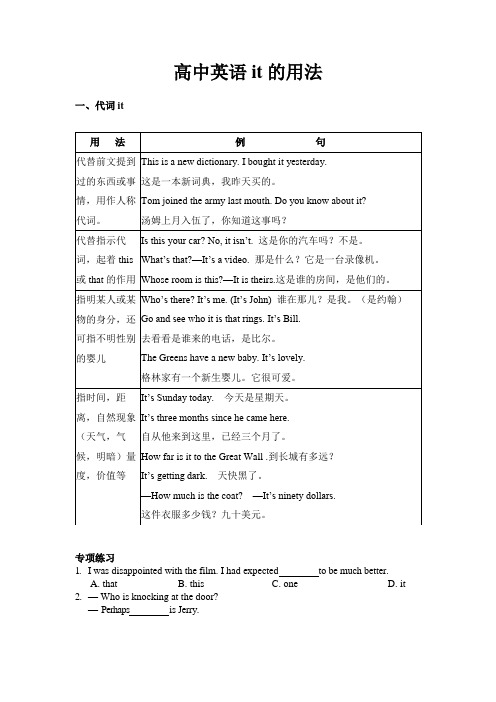
高中英语it的用法一、代词itA. heB. thatC. itD. theman3. Tom's mother kept telling him that he should work harder, but didn't work.A. heB. whichC. sheD. it4. —How _____ going?— Everything is OK.A. is itB. are theyC. is thatD. arethese5. — He was nearly drowned once.— When was ______ ?— _______ w as in 1998 when he was in middle school.A. that... ItB. this... ThisC. this... ItD. that...ThisKeys:1-5. D C D A A二、引导词it专项练习1. _______ is a fact that Global Warming has influenced human beings' life.A. ThereB. ThisC. ThatD. It2. It is wrong _______ treat your mother like that.A. that you toB. of you toC. for you toD.because you3. Is _______ n ecessary to complete the task before National Day?A. thisB. thatC. itD. he4. Does _____ matter if he can't finish the job on time?A. thisB. thatC. heD. it5. He hasn't had any food for two days. that he is so hungry.A. There is no pointB. There is no needC. It is no wonderD. It is no way6. ______ h e has been fired because of his absence for a long time with no reason.A. It is said thatB. They all said thatC. That is announced thatD. It was reported7. It is no use _____ books without reading.A. to buyB. in buyingC. of buyingD.buying8. _______ h uman beings can live on the moon in the next twenty years.A. There seems impossibleB. This is impossible forC. It is impossible ofD. It seems impossible that9. _______ i n the school regulation that students should wear school uniforms at school.A. What is requiredB. What requiresC. It is requiredD. It requires10. —How do you know him well?— ______that we live in the same neighbourhood.A. It isB. That isC. It is becauseD. Ithappens11. I don't think possible to complete the task without good preparation.A. thisB. thatC. heD. it12. I hate ______ when people talk with their full mouth.A. itB. thatC. theseD. them13. He _______ to do morning exercise in the park.A. took a ruleB. made a ruleC. made it a ruleD. tookit a rule14. I would appreciate _____ you would turn off the TV set.A. thatB. it ifC. these ifD. itthat15. I think _____ hard for you ______ t he task on your own.A. it is... doB. this... to doC. that is... doingD. it...to do16. Don't ______ for granted that he will keep his promise.A. take thatB. take itC. make thatD. makeit17. He soon ______ w hy he had done it.A. spoke clearlyB. made it clearC. told clearD. saidit clear18. Do you think _____ no use ______ another apology to him?A. it... to makeB. it is... makeC. it... makingD. that...of making19. We should regard _____ as a social duty to help these poor and homeless people.A. ourselvesB. theseC. itD. us20. I found ______to watch the football match on TV.A. it relaxingB. that is relaxingC. it relaxedD. thatis relaxedKeys:1-5 DBCDC 6-10 ADD CD11-15 DACBD 16-20 BBCCA三、it在强调结构中专项练习1.It was who telephoned me yesterday.A.him B.his C.himself D.he2. was a handbag that John gave Mary at Christmas.A.It B.This C.That D.Such3.Was the room the famous writer had ever lived in?A.that, it B.it , that C.it , where D.that, which 4.Why is it everyone thinks he’s a thief?A.because B.as C.when D.that5. is known to us Mary dances best.A.She, ×B.It, that C.It, she D.She, who Keys:1-5 AABDBKeys:1-5 DCDDA练习题:单项选择1. _______ that I was watching TV when he came to see me.A. It happenedB. What happenedC. That happenedD. It was happened2. The chairman thought necessary to invite Professor Smith to speak at the meeting.A. thatB. itC. thisD. him3. The Foreign Minister said, " ____ our hope that the two sides will work towards peace."A. This isB. There isC. That isD. Itis4. ______ is reported in the newspaper that the terrible flood has caused a loss of 10 million yuan.A. ItB. ThisC. ThatD. As5. It's up to you whether we should go to the art exhibition right now.A. decidingB. to decideC. of decidingD.decide6. Was ________ that I saw last night at the corner?A. it youB. not youC. youD. thatyourself7. It is about two months James leaves school. He is going to be a lawyer.A. whenB. beforeC. sinceD. that8. ______ turn is ______ to clean the blackboard?A. Which... itB. Whose... itC. Which... thatD.Whose. .. that9. The seriously injured man has stopped breathing. will be no possibility ofmaking him come to life.A. ItB. ThereC. ThatD. This10. Space exploration has been made with the development of modern science.A. it possibleB. it wasC. that being possibleD.possible11. To improve my spoken English, I make to recite a passage of English every day.A. a ruleB. it a ruleC. a rule thatD. arule it is12. He moved to a new flat because is only five minutes' walk from the new flat to his office.A. itB. thisC. thatD.there13. It was _______ several years I had an opportunity of seeing the bird again.A. for... beforeB. not for... thatC. for... whenD. notfor... then14. It was with the greatest difficulty the boy gathered the strength to rise.A. with whichB. thatC. whichD.what15. It is of great help Radio English on Sunday. It is well received.A. to pick upB. of picking upC. to pickD.picking upKeys: 1-5 ABDAB 6-10 ABDBD 11-15 BABBA基础题:一.单项选择:1. It is high time that our child to do some homework.A. learnedB. learnC. will learnD.would learn2. It is essential that every child the same educational opportunity.A. hasB. could haveC. haveD. had3. It was going to be some time he saw his parents again.A. sinceB. untilC. whenD.before4. _______ the 1500's_______ the first European explored the coast of California.A. It is not until... thenB. It was until... thatC. It's not until... whenD. It was not until... that5. I just wonder ________ that made them so depressed.A. why it didB. what they didC. how it wasD.what it was6. It was eight o'clock I got to the school this morning, made our teacher very angry.A. when... thatB. that... thatC. that... whenD.when... which7. ______ , they all went to the lake to swim.A. It was a hot dayB. Being a hot dayC. It being hotD. For it was a hot day8. I don't mind her criticizing me, but is how she does that I object to.A. itB. thatC. thisD.which9. — ______ seems to be something wrong with the machine.—Yes, _____ got a lot of noise.A. It... it'sB. There... it'sC. It... there'sD.There... there's10. ______ a certain doubt among the workers as to the necessity of the work.A. There areB. There isC. They areD. Itis11. Joan had often heard said that Marley had no money.A. oneB. onceC. itD. her12. When you go outing with your sisters, you must see to that they are safe.A. everythingB. itC. thatD.yourself13. He said, " a long way to school. a long way to go yet before we arrive."A. It is... There isB. There is... It isC. There is... There isD. It is... It is14. —Is it my age the boss minds?—I'm afraid not. He will consider necessary to have an experiencedassistant.A. which... itB. that... itC. which... thatD.that... that15. ______ easy to do the repair. All you need is a hammer and some nails.A. You areB. That isC. There isD. ItisKeys:1-5 ACDDD 6-10 DCABB 11-15 CBABD提升题:一、翻译。
(word完整版)it在高中阶段用法句型

It句型背诵一.It 做形式主语●to do 做真正的主语1. 我很方便和他取得联系。
It is convenient for me to get in touch with him.2. 你那样做是很愚蠢的。
It is stupid of you to do so.3. 我们听到那消息很惊讶。
It was amazing to us to hear the news4. 修长城花费了成千上万人很多年的时间。
It took thousands of people many years to build the Greatwall.●doing做真正主语5. 你和他理论是没有用的。
It is no use your arguing with him.6. 覆水难收It is no good crying over spilt milk.7. 雨天爬山真是有趣。
It is great fun climbing mountains on raining days.8这项工作值得做It is worthwhile doing the work.It is worthwhile to do the work.●that 做真正主语9. 他整天责备别人是不足为奇。
It is no wonder that he scolds others all day long.10. 据信他在国外学习/ 要去国外学习/ 去了国外学习。
It is believed that he is studying abroad / to go abroad for study/ has gone abroad for study. He is believed to be studying abroad/ to go abroad for study/ to have gone abroad for study.11. 我突然想起我忘了锁门。
高中英语it的用法的归纳总结

高中英语it的用法的归纳总结1. it 作为人称代词在句子中代替一个名词或代词,作为主语、宾语、表语或形式宾语等。
例句:It is raining heavily.The book is interesting. I love it.I find it difficult to understand.2. it 作为代词形式的宾语用在像 think, believe, find, consider, call 等动词后面,作为宾语,这些动词有时常被称为“感觉类动词”。
例句:I find it hard to believe that he would do such a thing.They called it a day and went back home.I consider it a waste of time to keep trying.3. it 作为形式宾语用在像 make, find, see, hear, feel 等动词后面,表示动作的对象。
例句:They made it clear that they would not accept the offer.I find it interesting to learn new things.I saw it with my own eyes.4. it 作为虚拟主语或虚拟宾语用在像 suggest, insist, demand, prefer 等动词后面,表示虚拟语气。
例句:The boss suggested that it would be better to start the project next month.She insisted that it was her right to make the decision.I demand that it be done as soon as possible.5. it 作为强调的主语或宾语用在像 be, have 等动词后面,表示强调。
初高中英语代词it用法总结
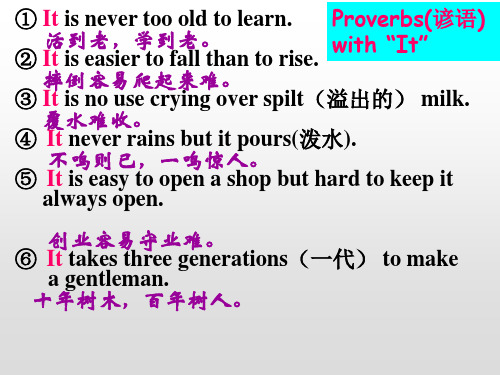
1.We think it our duty to clean our classroom every day.
2.I believe it important keeping notes. 3.He found it difficult that he would finish the task in
conclusion: it ---词性? _P__ro_n__. 可以用作人称代词,代指____前__文__提__到__的__事__物__. _ 还可以替代指示代词_t_h_is_._ 或_t_h_a_t_. _.
Discovering “It”
It is obvious that the water was to blame.
3.It is no good crying over spilt milk.
4.It is no use casting pearls before swine .
在S3与S4中,it的作用是__形__式__主_语__, __动__名_词__短__语____.构成如下结构:
真正主语是
It is/was +adj.
It is about 30km from Xi‘an to Lintong.距离 It lies in the south of Shaanxi. 地点 It is 40°C ! You got a high fever! 温度 It is December 17, 2009. 日期 What’s the baby doing? It ‘s swimming。性别不详的幼儿
高中英语之it的用法详解
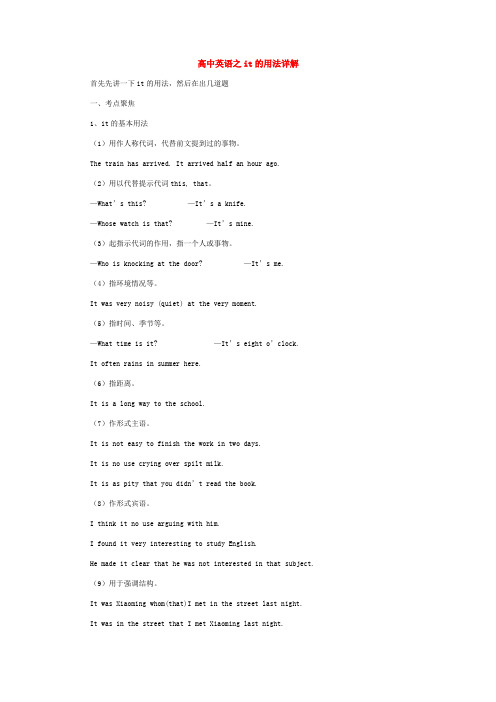
高中英语之it的用法详解首先先讲一下it的用法,然后在出几道题一、考点聚焦1、it的基本用法(1)用作人称代词,代替前文提到过的事物。
The train has arrived. It arrived half an hour ago.(2)用以代替提示代词this, that。
—What’s this?—It’s a knife.—Whose watch is that? —It’s mine.(3)起指示代词的作用,指一个人或事物。
—Who is knocking at the door? —It’s me.(4)指环境情况等。
It was very noisy (quiet) at the very moment.(5)指时间、季节等。
—What time is it? —It’s eight o’clock.It often rains in summer here.(6)指距离。
It is a long way to the school.(7)作形式主语。
It is not easy to finish the work in two days.It is no use crying over spilt milk.It is as pity that you didn’t read the book.(8)作形式宾语。
I think it no use arguing with him.I found it very interesting to study English.He made it clear that he was not interested in that subject. (9)用于强调结构。
It was Xiaoming whom(that)I met in the street last night.It was in the street that I met Xiaoming last night.It ws last night that I met Xiaoming in the street.It was I who met Xiaoming in the street last night.2、含有“It is …”的句型(1)It is time (for sb.) to do sth.It is (high) time that sb. did sth.(虚拟语气)(2)It is + 形容词(+of / for sb.)+ to do sth.通常用 of的词有brave、clever、careful、hopeless、kind、good、naughty、nice、silly、stupid、foolish、wise等。
- 1、下载文档前请自行甄别文档内容的完整性,平台不提供额外的编辑、内容补充、找答案等附加服务。
- 2、"仅部分预览"的文档,不可在线预览部分如存在完整性等问题,可反馈申请退款(可完整预览的文档不适用该条件!)。
- 3、如文档侵犯您的权益,请联系客服反馈,我们会尽快为您处理(人工客服工作时间:9:00-18:30)。
高中英语it的用法it的概念:it可用作人称代词、指示代词、先行词及引导词等。
it 的用法:1、it可指天气、温度、时间、距离等。
如:It is cold today, isn't it?2、用作人称代词,代替前文提到过的事物。
如:The dog is not acold-blooded animals. It doesn't need to hibernate.3、为避免重复,it可用来代替前面说过的短语或句子。
如:I tried to persuade my father to give up smoking, but found it impossible. (it=to persuade my father to give up smoking)4、代替指示代词this,that。
如:—What's this?—It's an album.—Whose new bike is that?—It's Mary's.注:it与one,that的区别:it=the(this, that)+名词,特指并且代替前面所提到的某特定事物。
如:He's bought a new car, so he drives it everywhere to show ito ff.one=a+名词,one指前面提到的同类事物中的不同的另一个。
如:He needs a computer, but he can't afford one.that=the+名词,that指代的名词与前面的名词属于同一类,但不属同一个。
如:The population of China is larger than that of Japan. that指代population,但其后有一个of短语作定语,以区别于the population of China。
注:it与that的异同:it指同一事物,that指同类但并不是同一事物。
如:I like the climate of Kunming more than that of Beijing.The climate of Kunming is mild, and I like it.5、It/This/That+be+the first(second, third...) time+that-clause 这个句型表示截止到说话时为止的某人的一种经历,关键是注意time前有序数词,主句是一般现在时is时,从句要用现在完成时;如果主句用一般过去时was时,则从句须相应地用过去完成时。
如:This is the first time(that) these Europeans have visited the Great Wall.It was the fifth time(that) I had paid a friendly visit to America.6、在一些相对固定的词组中,没有特殊含义,经常不翻译。
如:He's never really made it as an actor. 作为演员,他从未获得过真正的成功。
It is my turn. 轮到我了。
强调句中的it:可以用来改变句子结构,使句子的某一成分得到强调:1)强调句的基本句型it's/was+被强调成分+that/who+其他成分原句:I told Jim the news in our office yesterday.强调主语:It was I that/who told Jim the news in our office yesterday.强调宾语:It was Jim that I told the news in our office yesterday.或:It was the news that I told Jim in our office yesterday.强调地点状语:It was in our office that I told Jim the news yesterday.强调时间状语:It was yesterday that I told Jim the news in our office.2)强调句的一般疑问句型Is/Was+it+所强调部分+that/who...?如:Was it you that told Jim the news in your office yesterday?3)强调句的特殊疑问句型疑问词+is/was+it+that/who...?如:Who was it that told Jim the news in your office yesterday?【注】强调句与主语从句虽然在形式上很相似,即都含有it is(was)...that。
但,区别在于:强调句去掉it is(was)…that之后,句子结构仍然完整,而主语从句却不能这样。
如:(It is)our hope(that) the two sides will work towards peace.解析:去掉It is…that之后,句子是不成立的。
由此得出该句不是强调句,而是一个简单的主语从句,it是形式主语,从句是真正的主语。
“it”的用法:1、it 作形式主语:it 在句中可作形式主语,而真正作主语的主语从句需要放在句子的末尾。
主语从句后置常用以下几种结构:1)It is/was+adj.+subject-clause可用于此句型的形容词有:clear, certain, funny, good, impossible, likely, natural, obvious, possible, probable, strange, surprising, true, unusual, wonderful等。
如:It is obvious that going for sports will do a lot of good to your health.2)It+be+adj./n.(forsb./ofsb.)+todosth. 该句型中的形容词通常表示事物的特点或特征的,如:difficult, hard, easy, impossible, necessary, important等,此时用for;或表示人的性格特征或特点的,如:nice, good, bad, kind, silly, foolish, wise, clever, careless, rude, brave, cruel, careful, grateful等,这时要用of 。
3)It is/was+名词词组+subject-clause可用于该结构的名词词组有:a pity/duty, a good thing, no surprise, good news, an honor, a fact, a mystery, a shame, manners等。
如:It's a pity that I didn't attend the party.4)It is/was+V-ed+subject-clause可用于该结构的动词的过去分词有:said, reported, thought, supposed, believed, hoped, expected, known, decided, announced, arranged 等。
如:It is said that something had been done to end the pollution.注:本句还可改写为:Something is said to have been done to end the pollution.5)It+vi.+subject-clause可用于该结构的动词有:appear, seem, happen, occur等。
如:It appeared to scientists that the stars had moved.6)It doesn't matter(makes no difference,etc.) +连接代词或连接副词引起的从句作宾语。
如:It doesn't matter whether he'll join the army or not.It makes no difference where we have the conference.7)一些固定句型:It takes sb. some time to do sth.如:It will take you two days to get there on foot.It costs sb. some money to do sth.如:It costs 1,000 dollars to fly to America.It is/was no use(useless) doing(做什么是没有用处的)如:It's no use arguing with him.It is/was no good doing(做什么是没有好处的)8)以下句型结构中需要用虚拟语气①It is/was ordered(required, suggested, proposed) that...;It is/was a pity(a shame) that...表示遗憾等感情的句子中,主语从句要用“should+动词原形”,should可以省略。
如:It's necessary that he(should) be operated on at once.②It is (high)time that...结构中用should+动词原形(should不能省略)或动词过去式。
如:It is high time that you should make(made) full use of your time to go over your lessons.2、it作形式宾语:1)动词consider(feel, find, think等)+it+形容词(名词)+不定式(动词-ing形式,从句)。
如:She thinks it no use telling me.2)主语+appreciate(enjoy,like,love,hate)+it+if(when)...结构如:We would appreciate it if you could come to help us.3)dependon, relyon, see to(负责/设法做到), takeforgranted(习以为常)等短语后跟that从句时,要以it作形式宾语。
